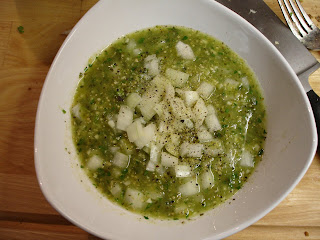I scurried from store to store and discovered, disappointingly, that nearly every store stocks the same vegetables and herbs, all supplied by a company called Bonnie, and very little variation on the tomatoes, cucumber, basil theme is allowed for. I found a few other items which made me pleased: A small variety of peppers, strawberries, rhubarb, arugula, and ah, now that I think of it, that's all. The rest of the assortment here now has been all my doing, looking back. Mine, and the Burpee seed people.
I wanted and needed more to replace what was once flower beds and will now bloom every shade of green: Not only to insure a balanced diet for my husband once I return home, but because the plants I mentioned above are the same things I have always grown roughly, since I began this subsistence patch-growing five years ago in Boston. I felt the pickings were both under-nourishing and boring. And that, my Friends, is where our problem began: At the seed packet shelves.
Looking back on it now, I realize two things, both of which are new pieces of information to me having always bought seedlings before: Many, many little seeds come in each of those little packets and some types of seeds are particularly survival hardy. The first thing that happened was that I planted about 60 seed cups of interesting and unusual-to-me sorts of subsistence things. My husband (born and bred rural, food growing, Kansan that he his) looked them over briefly and asked what was in them: Subsistence stuff, I said. No flowers.
After a while, small plants began to spring up. Other cups, like the spinach, yielded nothing. Josh came over again and asked what the little plants were. Butternut and acorn squash, I said, some leeks, zucchini, watermelon, and pumpkin. He is an engineer and it did not take him but a split second to take the lay of his land and divide by the number of vine and squash plants. Maybe there is room for a couple of squash and one watermelon, he said. You won't believe how big a watermelon gets! But he was willing to let me carry on as more and more of the home's old gardens-gone-by have had to be pressed back into service. I have 6 watermelon plants and as many pumpkin. Also, 4 cucumber, and twelve squash. This is not even mentioning the tomato cages, the pepper trees, the lemon and lime citrus trees and the kitchen herb garden. You are probably thinking of the two-page schematic of the many acres of Martha Stewart's garden in Bedford (hey there hometown!) published in her magazine? Think again. Our garden might be 30' x 4, but I was not going to let that stop me.
The second thing that happened was that Puppy, the guard dog/ cuddle bug, got his wiggly self into the seed packets one day while we were elsewhere and spread seed cheer all over. I picked up what seeds were too big to vacuum and flung them into the garden, figuring they were compost. My Kansan husband advises me since that, in fact, a seed is a seed is a seed. Which is very clear to me now that I see the broad leaves of more pumpkin, squash, and watermelon forming all over the garden, next to the avocado seeds I also "composted," and the patches of herbs and lettuces.
I will be going home shortly and leaving Josh to tend to this little patch of heaven I created for his greener sustenance. I am not sure why he looks at the garden with dread now, but I like to think it is his inability to express gratitude.
In the meantime, the onions have begun to sprout. And the cilantro, all 6 flats worth. It occurs to me I am building equity in food and gifts for the future: Fabulous potted cilantro plants with limes and red onions from the yard. And towards the fall, a veritable cornucopia of squash and pumpkins. Josh will have a marvelous time caring for all the ground and container plantings, I just know it.

The garden has yielded its first gift of the season, this fabulous Salsa Verde, which I served on Grilled Sweet-Rubbed Tri-Tip Tacos one night, and on Huevos Rancheros the following morning for brunch. I hope it gets your growing season off to a fresh start.

Salsa Verde
Adapted from Authentic Mexican Cooking by Rick Bayless
Makes about 3 cups
I do not care for onions to be too pungent or to leave a sharp taste after a meal. Anytime I use uncooked onion, as below, I cut the onion into halves or quarters before chopping, and allow the onion to soak in cold water for a few minutes. This takes down the sharpness of the flavor and prevents the green flavors from being unnoticeable in this sauce. If you prefer the bite of full-on onion, skip the first step and just add the chopped onion as the last item, after the processing is finished. Please take my advice and do not put the onion in the food processor, it will not make for a pleasant salsa, they are best added chopped at the end in all scenarios.
Keep in mind as you season the salsa that as the salsa sits in the fridge and the flavors macerate, the intensity of the salt will increase.
I use the slotted spoon to drain off a bit of the wateriness from the bowl before serving. When the salsa is placed over Huevos Rancheros or Nachos, you may wish to press out even a bit more of the water. It is up to you to decide the consistency you prefer.
1 small onion
6 large or 10 small tomatillos, hulled and washed
2 cloves garlic, roughly chopped
1/2 cup cilantro leaves
Juice of 1 lime
2 tablespoons italian flat-leaf parsely
Kosher salt and fesh ground black pepper to taste
Remove the tip end of the onion with your knife. Leaving the root end intact, slice the onion in half from top to bottom. Plunge the onion into a bowl of cold water large enough to cover the onion. Allow to sit for a minute to two, and remove the onion with a slotted spoon onto a paper towel, pat it dry. Now cut your onion into 1/2" dice and set aside.
Bring a large pot of water to a boil over medium heat. Drop all the tomatillos into the water and watch the clock for 8 minutes then remove them with a slotted spoon onto a plate lined with paper towel. Allow to cool for 10 minutes.
In the large bowl of your food processor, place the tomatillos, garlic cloves, cilantro, lime juice, and parsley. Pulse until the tomatillos are only roughly still intact (if you prefer a very smooth sauce, pulse until you reach your desired consistency). Transfer the salsa to a glass or porcelain bowl, not metal. Taste the salsa and season with salt and pepper to your liking. Add the diced onion and stir gently to combine. Cover and refrigerate at least one hour before serving, but overnight would be best.







No comments:
Post a Comment